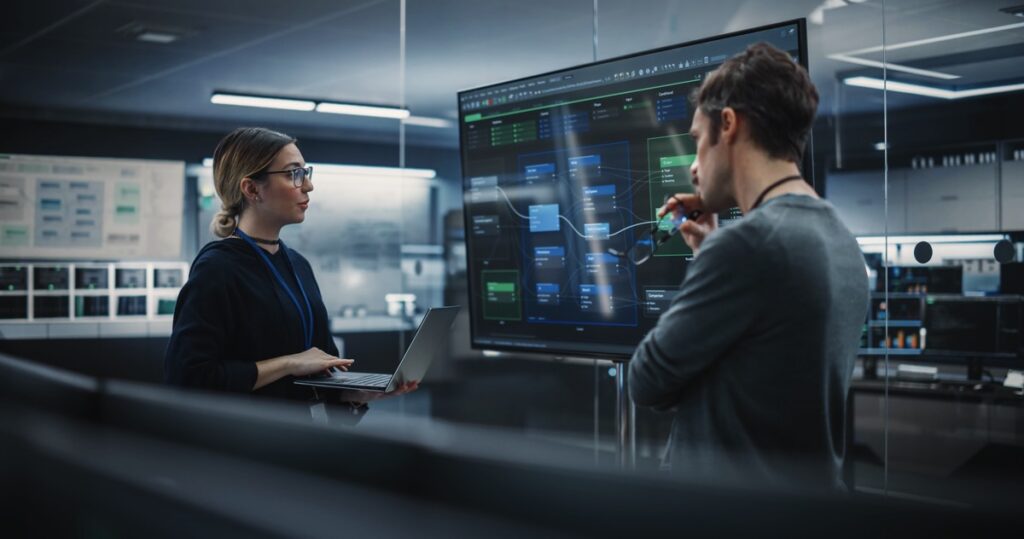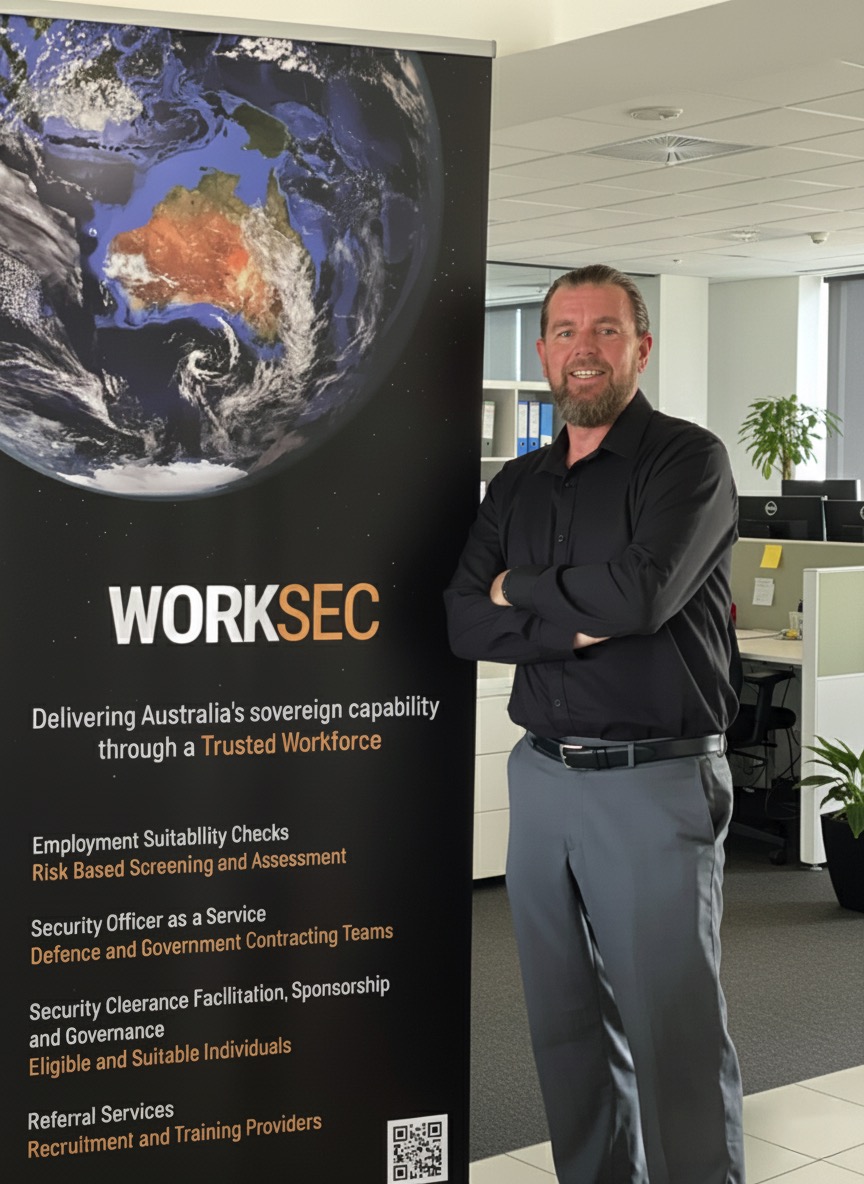Common Questions
Your questions answered. Find quick, reliable information about security clearances, personnel security governance and compliance, and how WorkSec can support you.

Security Clearances
Overview
A security clearance is an official authorisation that allows individuals to access classified or sensitive information within government operations. It ensures that only vetted and trustworthy individuals can handle information designated as Protected, Secret, or Top Secret, following the guidelines set out by the Australian Government Protective Security Policy Framework (PSPF).
You need a security clearance if your role involves accessing sensitive information or engaging in functions that require a high level of trust, such as those found in government, Defence, or Defence Industry positions. The clearance process is crucial for safeguarding national security and maintaining the integrity of sensitive information.
Learn more about Security Clearance Sponsorship.
Under the Australian Government Protective Security Policy Framework (PSPF), individuals who need access to security classified resources – including classified information, systems, or assets – must hold a security clearance.
You may also need a security clearance if you occupy a position of trust that requires additional assurance of integrity and reliability.
Clearances are not required to access information that is Official or Official: Sensitive, as these are not security-classified levels.
The four levels of Australian Government security clearances are:
- Baseline – permits ongoing access to classified resources up to and including Protected
- Negative Vetting 1 (NV1) – permits ongoing access to classified resources up to and including Secret, and temporary access to Top Secret in certain circumstances
- Negative Vetting 2 (NV2) – permits ongoing access to classified resources up to and including Top Secret
- Positive Vetting (PV) – permits ongoing access to Top Secret, including some caveated resources (Note: The Top Secret – Privileged Access (TS-PA) clearance will eventually replace PV and will be managed by the Australian Security Intelligence Organisation.)
WorkSec provides sponsorship of personnel security clearances at the Baseline, NV1, and NV2 levels. PV and TS-PA clearances are managed directly by government agencies and are not offered under the Defence Industry Security Program (DISP).
Most Defence and Defence Industry roles require applicants to hold a Baseline or NV1 clearance, depending on the level of classified information they will access.
While you may apply directly for NV1 or NV2 without first holding a Baseline, many applicants choose to secure a Baseline clearance first to begin work sooner while progressing toward higher levels.
Contact WorkSec if you’re unsure which clearance level applies to your role or project – our Security Officers can guide you through the right sponsorship pathway.
You cannot apply for a security clearance on your own; you need a sponsor to provide the personnel governance required for the maintenance of your clearance. A sponsor is a Government entity or a DISP member organisation that is able to formally endorse your need for access to classified information. They will facilitate your application and ensure that it adheres to the necessary protocols.
WorkSec can provide sponsorship for AGSVA Baseline, NV1, and NV2 personnel security clearances. As your sponsor, WorkSec assists in the application process and ensures that all necessary documentation and requirements are met for obtaining the respective security clearances. WorkSec provides the governance you need to attain and maintain a clearance.
Learn more about Security Clearance Sponsorship.
Eligibility and Suitability
In order to be eligible for an Australian Government security clearance, you must have:
- Australian Citizenship
- Checkable Background
AGSVA will also determine if an individual is suitable to hold a security clearance, by making an assessment of overall integrity using the following character traits:
- Honesty
- Trustworthiness
- Maturity
- Tolerance
- Resilience
- Loyalty
Visit the AGSVA website to learn more: Eligibility and suitability | Australian Government Security Vetting Agency
Yes. Although there are exceptional circumstances where the AGSVA may waive the Australian citizenship requirement, these are generally unavailable to Defence Industry as they require a specific set of conditions:
- The foreign national is necessary to meeting a critical objective.
- The role cannot be redesigned so that access to classified information or resources is restricted.
- The role cannot be performed by an Australian citizen.
- There is no conflict of interest in relation to the foreign national’s country of allegiance and the role being undertaken.
- The foreign national is a permanent resident, is actively seeking citizenship and the process will be concluded in a reasonable period.
Further information on what documentation you will need can be found at AGSVA | Security Officers | Sponsoring a New Clearance under the section Foreign nationals and citizenship waivers.
Past legal issues or convictions can affect your eligibility for a security clearance; however, the implications are evaluated on a case-by-case basis. Not all criminal records automatically disqualify an individual from obtaining a security clearance. The assessment considers various factors, including:
- The nature of the offence: Seriousness and relevance of the crime.
- The time elapsed since the incident: How long ago the offence occurred and if there is a pattern of behaviour.
- Evidence of rehabilitation: Demonstrating that you have made positive changes in your life since the offence.
It is crucial to be transparent and honest about your criminal history during the clearance process. Full disclosure can significantly impact the assessment outcome positively compared to withholding information.
If you have held a security clearance in the past you can log onto the AGSVA’s myClearance portal and check the status of your security clearance: https://myClearance.gov.au.
If you are seeking sponsorship through WorkSec and do not know your Clearance Subject ID (CSID) or no longer have access to the email address that the AGSVA has on file, our Security Officer team can check your existing clearance status if you provide your full name and date of birth. Alternatively, please call the AGSVA on 1800 640 450.
Application Process
Referees are required for both the WorkSec Employment Suitability Check (ESC) and the Australian Government Security Vetting Agency (AGSVA) vetting process. They play an important role in verifying the information you provide and assisting with your suitability assessment.
Each clearance level has specific referee requirements:
- Baseline – 1 professional referee covering at least the last 3 months
- Negative Vetting 1 (NV1) – 1 professional referee (last 3 months) and 1 personal referee who can comment on the past 10 years
- Negative Vetting 2 (NV2) – 1 professional referee (last 3 months) and 1 personal referee who can comment on the past 10 years
You may nominate multiple referees to meet these requirements.
When choosing referees, consider the following:
- Your professional referee should ideally be your current supervisor and have supervised you for at least the last 3 months. If this isn’t possible, a previous supervisor from the past 12 months can be used.
- If you haven’t worked in the past 12 months, personal referees may be nominated instead.
- Referees must have known you personally or professionally for at least 3 months and had regular contact during that period.
- Referees must be able to provide an objective assessment – close relatives, partners, doctors, or teachers are generally not suitable.
- Where possible, referees should be Australian citizens or permanent residents. If overseas, they must be contactable by phone, video, or email.
- Ensure your referees are aware of the process and willing to participate.
Contact WorkSec if you’re unsure who to nominate – our Security Officers can help you identify suitable referees based on your circumstances and clearance level.
Once your security clearance request has been submitted, the Australian Government Security Vetting Agency (AGSVA) will email you login details for the myClearance system. You’ll have up to 20 business days to complete your application and upload all required documents.
You’ll receive a personalised checklist of documents to provide – it’s important to upload everything listed. If a document is missing, you’ll need to complete a Statutory Declaration explaining why. AGSVA may contact you or your referees if any additional information is needed.
After your application is submitted, AGSVA will review it to ensure it’s complete. Once accepted, the vetting assessment begins. Depending on your clearance level, this may include:
- Identity verification and citizenship checks
- Referee interviews and background verification
- Travel history and digital footprint checks
- National Police and financial probity checks
- Security assessment interviews or psychological assessments, if required
- ASIO assessment for higher-level clearances
Your case will be assigned to a vetting officer, who reviews all information and makes a recommendation regarding your suitability to hold a clearance. A decision maker from AGSVA will then review the recommendation and make the final determination, with both you and your sponsor notified of the outcome.
Download the AGSVA Security Clearance Applicant Guide Book to understand what documents and checks may apply to your clearance level or Contact WorkSec for further information.
In accordance with the Protective Security Policy Framework (PSPF), WorkSec conducts comprehensive Employment Suitability Checks (ESCs) before submitting any clearance application to the Australian Government Security Vetting Agency (AGSVA). These checks assess eligibility and suitability against the PSPF and AS4811:2022 standards. If any circumstances are identified that are likely to result in a negative vetting outcome, WorkSec will advise the applicant and sponsoring organisation prior to lodgement with the AGSVA.
If, during the vetting process, clearance applicants are assessed as not suitable to hold a security clearance, AGSVA initiates a procedural fairness process.
The clearance applicant is advised of AGSVA’s concerns and is provided an opportunity to respond. AGSVA will consider all of the information, including the clearance applicant’s response, before making a final decision on the outcome of the security clearance assessment.
If you’re unsure about your eligibility or suitability, or believe there may be factors that could affect your clearance, contact WorkSec to confidentially discuss your personal circumstances before beginning the process.
Yes. AGSVA charges fees to government agencies and defence industry sponsors for security clearance assessments. This ensures adequate resourcing and recovery of security vetting service costs in an environment of growing demand for clearances.
WorkSec passes through AGSVA’s vetting fees, and also charges a once off fee for the employment suitability check, as well as an annual sponsorship fee to cover the Security Officer and governance duties required for you to maintain your clearance in line with DISP and PSPF obligations.
Often, employers will cover these fees where security clearances are required for Defence or Government engagement. In some cases, costs may also be tax-deductible, so it’s worth checking with your accountant.
Contact WorkSec today for a quick quote or to confirm your eligibility and sponsorship options — our team can help you understand exactly what applies in your situation.
Timeframes
The expected time-frame for obtaining a security clearance varies depending on the level of clearance you are applying for. Below are the typical processing times for each type of clearance:
- Baseline Clearance: Approximately 1 month.
- Negative Vetting Level 1 (NV1): Approximately 3 months.
- Negative Vetting Level 2 (NV2): Approximately 5 months.
These time-frames can be affected by various factors, including the completeness of your application, the speed of background checks, and the workload of the AGSVA at the time of your application. It’s important to ensure that all documentation is accurately filled out and submitted promptly to help expedite the process.
The Australian Government Security Vetting Agency (AGSVA) tracks performance to ensure key performance indicators (KPI) are met. Their current performance can be viewed here:
Key performance indicators | Australian Government Security Vetting Agency.
Please note that the AGVSA KPIs advertised begin once your application has been submitted and verified as complete (ie progressed to the ‘Assessment in Progress’ stage).
The duration of a security clearance depends on its level. Each clearance is subject to periodic revalidation by the Australian Government Security Vetting Agency (AGSVA) to ensure ongoing suitability and eligibility.
Revalidation periods are as follows:
- Baseline – every 15 years
- Negative Vetting 1 (NV1) – every 10 years
- Negative Vetting 2 (NV2) – every 5 to 7 years
- Positive Vetting (PV) – every 5 to 7 years
During the revalidation process, AGSVA will contact both the clearance holder and their Security Officer by email and SMS to commence a review of circumstances and reissue the clearance application.
A clearance remains active as long as sponsorship is maintained with an approved DISP member organisation. If a clearance holder’s sponsorship is withdrawn (for example, they leave a sponsored role), the clearance may be downgraded or cancelled.
Following the introduction of myClearance in November 2022, AGSVA temporarily paused revalidations. While some clearances may show an expired date, AGSVA has now resumed revalidation activities, and affected clearances remain valid if there is an active sponsor in place.
If your clearance has expired and you wish to return to a cleared role, contact WorkSec to discuss your options for sponsorship and reapplication.
If you already hold a security clearance but are currently unsponsored, WorkSec can assist with reactivation once sponsorship is established.
Before reactivation, WorkSec will conduct an Employment Suitability Check (ESC) to confirm your eligibility and suitability – this process typically takes around five business days.
If your clearance has been inactive for less than three months, reactivation is generally instant once WorkSec registers an interest in your clearance with the Australian Government Security Vetting Agency (AGSVA).
If you have been unsponsored for longer, AGSVA may request a Change of Circumstances (CoC) to update details such as employment, residence, or other relevant changes since you were last sponsored. Your clearance will usually be reinstated pending CoC processing, with typical timelines of 1–2 weeks, depending on complexity and AGSVA workload. In some cases, AGSVA may reactivate your clearance immediately after submission while the CoC is still being reviewed.
Contact WorkSec today to begin the sponsorship process and confirm the fastest reactivation pathway for your existing clearance.
If your existing security clearance has expired, you cannot simply reactivate it. You will need to reapply for a new clearance, which involves submitting a fresh application and undergoing the full vetting process conducted by the Australian Government Security Vetting Agency (AGSVA).
Security clearances are valid for specific periods before requiring revalidation:
- Baseline – every 15 years
- Negative Vetting 1 (NV1) – every 10 years
- Negative Vetting 2 (NV2) – every 5 to 7 years
- Positive Vetting (PV) – every 5 to 7 years
If your clearance has passed its revalidation date and you were not actively sponsored at that time, you would not have been eligible for revalidation and your clearance will have lapsed. However, if you remain within the revalidation period of a lower clearance level, you may still be eligible for sponsorship at that level while reapplying for a higher one.
Following the release of myClearance in November 2022, AGSVA temporarily paused revalidations, which means some clearances may show a lapsed or past expiry date. However, AGSVA has now resumed revalidation activities, and clearances remain valid while there is an active sponsor. If sponsorship is removed, a clearance may be downgraded or cancelled.
If your clearance has expired or you’re unsure about your eligibility for sponsorship, contact WorkSec to discuss your options and confirm your current clearance status.
Defence Industry Security Program
Overview
Australian entities seeking to partner with Defence have an obligation to contribute to the security of Defence people, information and assets.
There are many things an entity can do to minimise security risks and raise their level of security. The Defence Industry Security Program (DISP) supports Australian entities to understand and meet their security obligations when engaging in Defence tenders, contracts and projects.
DISP is a multi-level membership-based program. It’s underpinned by the Defence Security Principles Framework (DSPF), Principle 16, Defence Industry Security, Control 16.1, Defence Industry Security Program.
The purpose of DISP is to:
- ensure industry has the right security in place for Defence tenders and contracts
- provide industry with access to security advice and support services
- help industry to understand and manage security risks
- provide assurance to Defence and other government entities when working with DISP members.
Eligibility and Suitability
DISP membership is mandatory for entities who:
- work on classified information or assets (i.e. PROTECTED and above)
- supply, maintain, store or transport weapons or explosive ordnance
- provide security services for Defence bases or facilities
- need to hold DISP membership as a condition of a Defence contract.
The only exceptions are when an entity is:
- working on classified information or assets, but they will be doing so only within Defence facilities or using Defence networks
- recognised under an applicable Security of Information Agreement or Arrangement (SIA).
Any Australian entity can apply for Defence Industry Security Program (DISP) membership.
Industry entities who wish to apply for DISP membership are required to meet several eligibility criteria that are defined in the Defence Security Principles Framework (DSPF) – Principle 16 Control 16.1. It provides principles, controls and instructions to support entities to understand and manage security risks when engaging with Defence.
An entity must:
- Be registered as a legal business entity in Australia with an Australian Business Number (ABN).
- Be financially solvent.
- Have a Director or senior executive who is able to:
- obtain an Australian Personnel Security Clearance (commensurate with the level of membership)
- obtain an Australian Digital ID.
- create a Relationship Manager Authorisation account and be the principal authority
- fulfil the roles of CSO.
- Have a staff member who is able to:
- obtain an Australian Personnel Security Clearance (commensurate with the level of membership)
- obtain an Australian Digital ID.
- fulfil the role of SO (the CSO and SO can be the same individual).
- Establish and maintain security standards for their requested level of membership.
- Establish the entity’s risk of Foreign Ownership, Control or Influence (FOCI).
- A FOCI assessment examines the extent of control the entity is under from a foreign entity or entities.
- FOCI analysis is aligned with the The Treasury’s Foreign Investment and Review Board.
- It provides information to Defence contracting areas to support their security risk management activities and make informed decisions when assessing security risks associated with the procurement of goods and services.
- Submit a FOCI declaration form as part of the DISP application process, and when there are potential or actual changes in FOCI status. Information includes, but is not limited to:
- foreign Directors
- foreign Board members
- foreign shareholders
- foreign revenue streams
- agreements with foreign persons
- foreign investments.
All information obtained is held in accordance with legislative requirements under the Privacy Act 1988 and the Freedom of Information Act 1982.
DISP also considers the following when assessing eligibility:
- Any risks arising from an entity’s previous or current commercial activities with any listed terrorist organisation or entity linked to any listed terrorist organisations (as listed under the Criminal Code Act 1995 (Cth)), or to persons for mercenary, terrorist or other criminal activity.
- Any relationships with regimes subject to Australian sanctions laws including the United Nations Security Council sanctions regimes and Australian autonomous sanctions regimes.
- Any relationship with persons or entities on the Department of Foreign Affairs and Trade Consolidated List.
If an entity meets the eligibility criteria they can apply for DISP membership. Once an application is received by DISP an assessment to confirm eligibility and determine suitability is conducted.
Suitability is assessed against the DSPF Principle 16, Control 16.1.
Applicants self-nominate the membership level they need to meet their business needs. The entity’s suitability is assessed against the level of membership it applies for. Appropriate justification is required to support higher levels of membership.
An overseas entity cannot be a DISP member. However, foreign entities can still pursue opportunities to work with Defence on Australian classified contracts if certain conditions are met including:
- The country from where the foreign entity originates must be party to a Security of Information Agreement or Arrangement (SIA) with Australia.
- If a SIA is in place, the foreign entity’s security practices and clearances need to be verified. Foreign entity security practice verification is achieved through recognition of a Facility Security Clearance at the government-to-government level.

Ready to
Get Started?
Whether you’re an individual seeking clearance or an organisation needing personnel security services, reach out to WorkSec today to take the next step in securing your future.

Services
WorkSec offers tailored security services, including security clearance sponsorship, personnel screening, and outsourced governance. Our solutions help clients stay compliant and protected while meeting the demands of critical industries.

Tailored Solutions
WorkSec services clients Australia-wide, as well as international organisations employing Australian citizens. Our diverse clientele ranges from individuals seeking security clearance to recruitment agencies and enterprises requiring personnel security and compliance solutions.

Ready to secure your pathway into Defence and Government?
Whether you’re applying for a new clearance, reactivating an existing one, or upgrading to a higher level, WorkSec provides the sponsorship and governance you need to move through AGSVA vetting with confidence.
